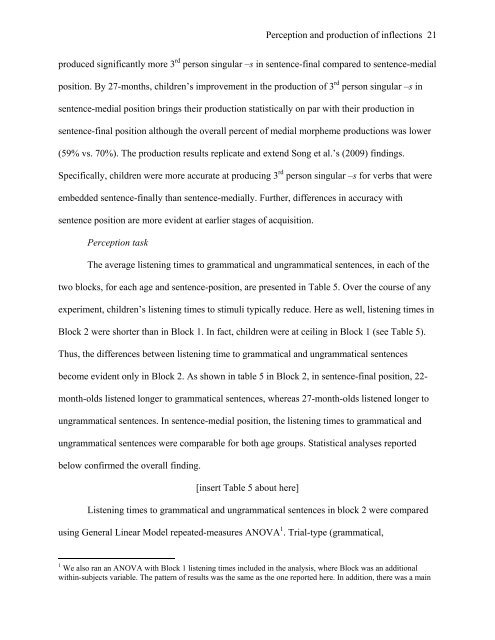Perception and production of inflections 1 Sentence-position effects ...
Perception and production of inflections 1 Sentence-position effects ...
Perception and production of inflections 1 Sentence-position effects ...
Create successful ePaper yourself
Turn your PDF publications into a flip-book with our unique Google optimized e-Paper software.
<strong>Perception</strong> <strong>and</strong> <strong>production</strong> <strong>of</strong> <strong>inflections</strong> 21<br />
produced significantly more 3 rd person singular –s in sentence-final compared to sentence-medial<br />
<strong>position</strong>. By 27-months, children’s improvement in the <strong>production</strong> <strong>of</strong> 3 rd person singular –s in<br />
sentence-medial <strong>position</strong> brings their <strong>production</strong> statistically on par with their <strong>production</strong> in<br />
sentence-final <strong>position</strong> although the overall percent <strong>of</strong> medial morpheme <strong>production</strong>s was lower<br />
(59% vs. 70%). The <strong>production</strong> results replicate <strong>and</strong> extend Song et al.’s (2009) findings.<br />
Specifically, children were more accurate at producing 3 rd person singular –s for verbs that were<br />
embedded sentence-finally than sentence-medially. Further, differences in accuracy with<br />
sentence <strong>position</strong> are more evident at earlier stages <strong>of</strong> acquisition.<br />
<strong>Perception</strong> task<br />
The average listening times to grammatical <strong>and</strong> ungrammatical sentences, in each <strong>of</strong> the<br />
two blocks, for each age <strong>and</strong> sentence-<strong>position</strong>, are presented in Table 5. Over the course <strong>of</strong> any<br />
experiment, children’s listening times to stimuli typically reduce. Here as well, listening times in<br />
Block 2 were shorter than in Block 1. In fact, children were at ceiling in Block 1 (see Table 5).<br />
Thus, the differences between listening time to grammatical <strong>and</strong> ungrammatical sentences<br />
become evident only in Block 2. As shown in table 5 in Block 2, in sentence-final <strong>position</strong>, 22-<br />
month-olds listened longer to grammatical sentences, whereas 27-month-olds listened longer to<br />
ungrammatical sentences. In sentence-medial <strong>position</strong>, the listening times to grammatical <strong>and</strong><br />
ungrammatical sentences were comparable for both age groups. Statistical analyses reported<br />
below confirmed the overall finding.<br />
[insert Table 5 about here]<br />
Listening times to grammatical <strong>and</strong> ungrammatical sentences in block 2 were compared<br />
using General Linear Model repeated-measures ANOVA 1 . Trial-type (grammatical,<br />
1 We also ran an ANOVA with Block 1 listening times included in the analysis, where Block was an additional<br />
within-subjects variable. The pattern <strong>of</strong> results was the same as the one reported here. In addition, there was a main
















